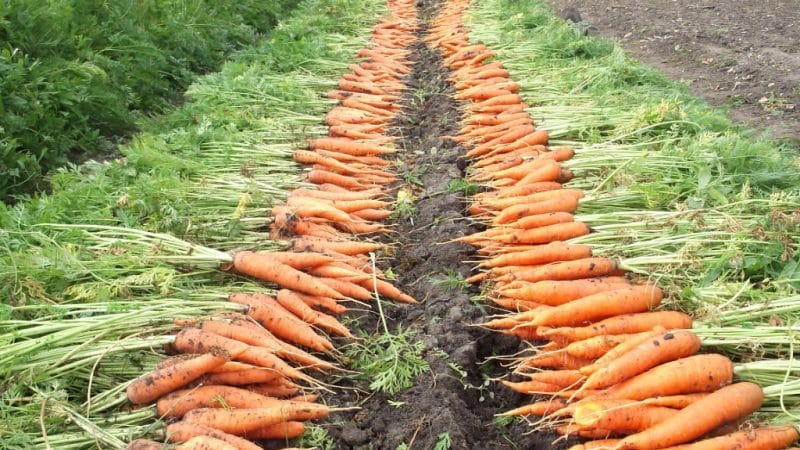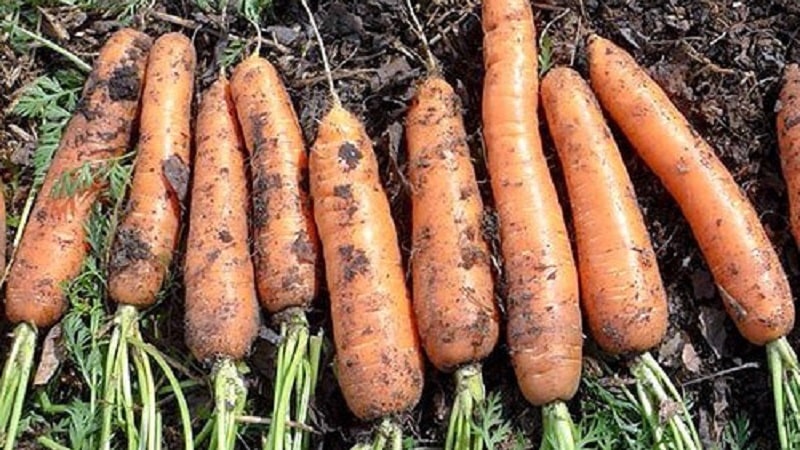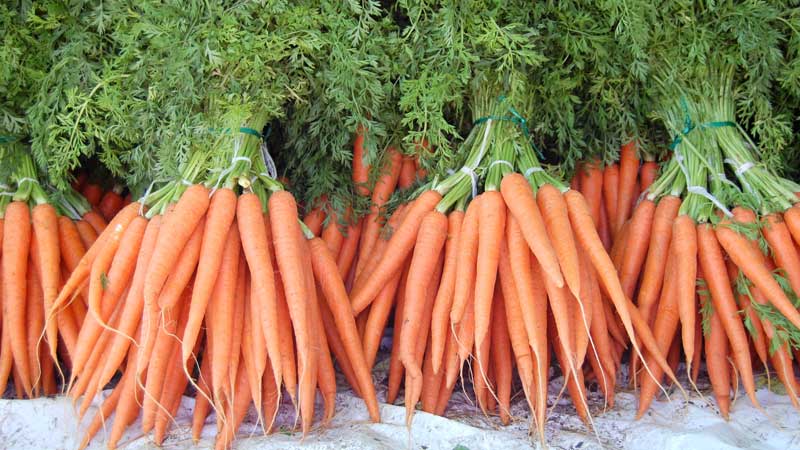What is the carrot yield per 1 hectare, what does it depend on and how to increase it
Carrots are a healthy, unpretentious, profitable biennial plant. The root crop is consumed fresh, canned, or thermally treated. Today we will tell you how to grow high-quality root vegetables and what measures to take to increase carrot yields.
What is the carrot yield per 1 hectare
The carrot yield per 1 ha depends on varieties, climatic conditions, ripening periods:
- for early ripening varieties - 30-60 tons;
- for mid-season varieties – 40-70 tons;
- for certain high-yielding varieties - up to 100 tons.

Averages
If the sowing rules are followed, the number of vegetables harvested per 1 m² of area depends on the variety and has the following values:
- early ripening varieties receive 3-6 kg;
- mid-season or late produce 4-7 kg;
- Some varieties provide up to 10 kg.
How much can you collect from 1 hundred square meters?
From 0.5 to 1 ton of root crops are collected per hundred square meters. Yields are affected by:
- climatic conditions;
- soil quality;
- soil aeration;
- proper care of crops.
Average yield values by ripening period are:
- early varieties provide 300-600 kg;
- mid- or late ripening produce 400-700 kg;
- individual varieties – up to 1 t.
By creating better aeration conditions, they increase:
- the weight of root crops is 1.9 times;
- length 1.8 times.
In hot conditions, small root crops grow, so averages are not an accurate indicator.
What does productivity depend on?

For a bountiful harvest, prepare the seeds and soil:
- choose a variety that is resistant to diseases and pests;
- select high-quality seeds from trusted producers with a shelf life reserve;
- treat the seeds with growth stimulants and soak them in water overnight;
- observe crop rotation - plant after onions, potatoes, cabbage, cucumbers, tomatoes;
- before planting, dig up the beds to a depth of 30 cm;
- fed with organic and mineral fertilizers;
- deoxidize the soil (if necessary);
- sow seeds before the heat sets in on the sunny side;
- thin out after the appearance of 2-3 leaves;
- water regularly;
- Harvest at temperatures not lower than 0°C.
Favorable temperature for seedlings is +5°С, for obtaining bright colors – +16…+22°С.
Important! Deoxidizers and fertilizers are not applied at the same time. In the fall - deoxidizers, and in the spring - fertilizers.
You cannot sow carrots after:
- parsley;
- dill;
- parsnip;
- celery.
Carrot yield per 1 ha depending on the growing region

The largest volumes of carrots are grown in the Moscow, Volgograd, Rostov, Novgorod, Samara, Sverdlovsk regions, Krasnodar and Primorsky Territories.
The average yield is:
- Volgograd region – 244 c/ha;
- Moscow region - 525 c/ha;
- Rostov region – 129 c/ha;
- Samara region - 300 c/ha;
- Novgorod region - 325 c/ha.
We grow it correctly to get a good harvest.
To increase crop yields, fertilizers are applied in the spring:
- in peat soil - 5 kg of river sand and 3 kg of mullein;
- The chernozem is loosened, then 2.5 liters of sawdust are added to a bucket of sand;
- 5 liters of humus with sawdust are added to the sandy soil.
Before sowing, weeds, wireworm and May beetle larvae are removed. The grains are placed in wet furrows and sprinkled with earth or sand.
Important! Do not fertilize the soil with fresh manure.
The most productive varieties

Climatic conditions, sowing dates and soil types influence yields.
The best varieties:
- Nantes - the most popular variety. Length/diameter – 18 cm/5 cm, weight – 165 g.
- Touchon – early ripening variety for open ground. The growing season is 70-90 days. The root vegetables are bright red, the length of the vegetable is 20 cm, the weight is 150 g. 3-5 kg are collected from 1 m².
- Alenka – a disease-resistant variety. The length of the root crops is 14-16 cm, they ripen in 90-100 days, the yield is more than 10 kg per 1 m².
- chastener. Good shelf life, high content of vitamins, growing season – 80-100 days, root length – up to 14 cm, weight – 100 g, harvested up to 7 kg per 1 m².
- Losinoostrovskaya 13 is characterized by keeping quality and a large amount of carotene. The length of root crops is 15-18 cm, harvested from 5-8 kg per 1 m².
- Moscow winter. The shape of the root crops is conical, carrots have a strong aroma, the growing season is 70 days, length/diameter is 18 cm/5 cm.
Secrets of agricultural technology to increase productivity
Experienced gardeners pay attention to ensure that varieties are suitable for growing in specific climatic conditions. Necessary conditions for good yield:
- the variety corresponds to the soil type;
- the soil is moist, loose, drained at a depth of 30 cm;
- stones and roots that deform the root crops have been removed from the garden bed;
- when tested, the acidity of the soil is 6-6.5 pH;
- Fertilizers are applied to the ground in accordance with the type of soil;
- plantings are mulched with chopped bark or straw to retain moisture and looseness;
- Urea was added to the soil - 100 g per 30 m²;
- carrot sprouts are constantly thinned out;
- groundwater is at a depth of 0.8-2.5 m.
How to tell when your crop is ready to harvest

Early varieties ripen in summer and are unsuitable for long-term storage.If they are not removed in time, the root crops will crack in the soil and lose their juiciness and taste.
Average ripening carrots take 80-110 days to grow before harvesting. For winter storage, varieties with late ripening periods are used. They grow for more than 110 days. The harvest is harvested in the first three weeks of September, in dry weather. Root crops are not left until the first frost - they can be affected by gray rot.
Signs of vegetable ripening:
- the upper part of the root crop is above the ground;
- yellowed lower leaves of mid-season carrots;
- white roots on the side surface of carrots.
When cracks appear on a vegetable, the crop is urgently dug up.
Advice. A reliable way to check maturity is to dig up the root crop and see if its size matches what the seed manufacturer claims.
Methods for harvesting carrots
Carrots are harvested in dry, clear weather at a temperature of +4...+6°C in the following ways:
- pulled by hand by the tops;
- First they dig in with a pitchfork or shovel, then they pull it out with their hands.
If the crop is harvested in dry weather, the soil is moistened the day before harvesting. Root crops are easier to pull out of moist soil. After harvesting, the tops are trimmed and the top of the root crop (2 mm).
Attention! Do not shake the soil off the carrots by hitting them against each other. Fresh, juicy root vegetables will be damaged, which will affect their shelf life.
Conclusion
Sowing and caring for carrots is not a difficult task. By following planting rules, taking into account climatic conditions and maintaining the timing of harvesting root crops, gardeners receive a rich harvest of healthy vegetables.